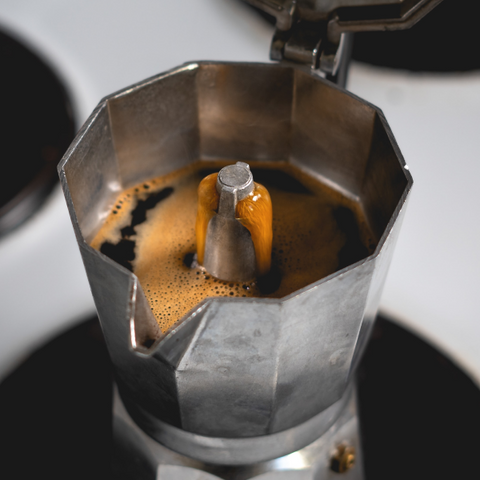Strong, sweet, rich — what sounds like the description on a dating profile is actually the qualities of your new true love: Cuban coffee, also known as cafecito.
A favorite beverage not only on the island of Cuba but also in Cuban diaspora communities, cafecito is easy to make and almost too easy to drink. In this post, we’ll discuss what Cuban style coffee is and provide a Cuban coffee recipe to make and enjoy it yourself.
Let’s dive in to discover what makes Cuban coffee taste so unique!
What is Cuban Coffee?

“Cuban coffee,” broadly speaking, is more than just one drink, though the term has also become synonymous with the particular beverage, which we’ll discuss here in a moment.
Instead, coffee for Cubans at home and abroad is a deeply ingrained part of the culture — a catalyst for meeting friends, sharing conversation and community, and even just taking a moment out of a day to savor the familiar, comforting taste of any number of coffee drinks. This includes the signature drink we will teach you how to make, which is most often referred to as “Cuban coffee,” but also known as “Cubano,” "Café Cubano," "Cuban espresso," or “Cafecito.”
The first coffee plantation in colonized Cuba was established in 1748, and the island’s coffee industry started booming in the 1790s. With the increase in production also came a rise in consumption, which has not been the case in many coffee-growing countries. Sugar and coffee production continued apace, and the Cubano is their perfect marriage: A Cubano or Cafecito is a combination of rich, strongly-brewed coffee with a hefty dose of sugar that has been whipped into a foam, providing the drink’s signature texture.
The Cuban coffee industry began to struggle after the Cuban Revolution, partly due to land redistribution; the decline continued after the U.S. placed an embargo on Cuban export goods, which caused a loss of revenue for farmers. Still, the drink has become such a part of Cuban culture that “Cuban-style” coffee brands like Café Bustelo, Café la Llave, Café Pilon, and Café La Carreta are popular staples in Latin communities in the United States.
The coffee is usually a darker roast with a chocolaty, nutty, and cereal-like flavor profile. Familiar with how to use a Moka pot? Café Cubano can be made at home using a Moka coffee pot on the stove (see instructions below), and it’s also on the menu at many Latin cafés and restaurants that use an espresso machine. An espresso shot can also be used as the base for Cuban-style coffee drinks like the cafe con leche or cortadito that involve milk or cream, but the key part of a Cubano is the espuma, or foam that’s made by whipping sugar with a little bit of coffee liquid. Discover more about drinking coffee with milk if you’re interested in trying a cafe con leche.
In Miami, the U.S. city with the most Cuban flair, there are countless ventanitas, walk-up windows where you can order coffee and a sweet or savory pastry, or Cuban bread. Each may pride itself on being the best Cuban coffee maker, and locals may argue about which serves the most authentic Cuban coffee, but order a cafecito and you’ll be momentarily transported to Havana.
What You Need to Make Cuban Coffee
- A stovetop espresso maker aka Moka pot for brewing (smaller is better; Cubano is meant to be a single-serve beverage of stronger coffee, as opposed to its larger cousin, Colada coffee)
- Dark-roasted ground coffee is preferable for authenticity, but you can use any coffee that’s to your taste
- Demerara, white, granulated, or brown sugar (1 tbs per serving, adjust to taste)
- A teaspoon
- A small whisk
- Serving cups (espresso cup or demitasse cup)
How to Make Cuban Coffee
- Grind the desired amount of cuban coffee beans to medium-fine. Use a coffee grind size chart to get a better idea of what
- Fill the bottom chamber, of your Moka pot with water until it reaches just below the steam release valve
- Fill the basket to the top with coffee grounds, and use your finger to even out the bed of grinds, but do not press down
- Place the filter basket into the bottom chamber, and screw on the top chamber tightly
- Place the Moka pot on a burner over high heat
- Crack open the lid and keep an eye out while the water in the bottom chamber heats up (this should take a few minutes)
- While the water is heating, measure out your sugar in a measuring cup
- When the coffee starts flowing into the top chamber, take the teaspoon and collect 1–2 tsp of coffee liquid. Add it to the sugar, and vigorously whisk until you achieve a creamy, tan-colored foam (espuma)
- When the coffee stream starts sputtering more and runs closer to clear, close the lid and immediately pour the coffee into your serving cups
- Top with equal amounts of foam, and enjoy









